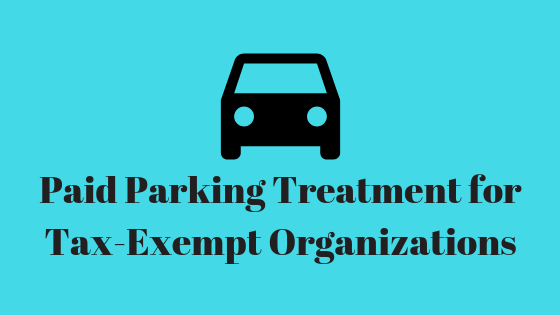In late 2018, the Treasury Department issued further guidance on how tax-exempt organizations should be treating paid commuting and parking provided to employees, commonly referred to as qualified transportation fringe benefits.
Generally, gross income to the employee does not include qualified transportation fringe benefits, or “QTF.” A QTF may be paid directly to the employee in the form of reimbursement or paid by the employer as an in-kind benefit.
The 2018 Tax Cut and Jobs Act will now require tax-exempt nonprofits to pay taxes on such benefits. The nonprofit organization would report these benefits provided to employees on form 990-T, and likely owe unrelated business income tax.
The IRS issued the following explanation of the “Increase in unrelated business taxable income by disallowed fringe benefits.”
For organizations that have employees, unrelated business taxable income (UBTI) is increased by
The tax will be applicable for employers paying for employee parking directly to a third party as well as those who lease or own their parking facility.
For those paying for employee parking to the employee or a third party, the UBTI is simply calculated as the organization’s total annual cost of employee parking paid.
For those who lease or own their parking facility, the IRS has provided four steps to assist nonprofits of all sizes in determining how to apply the rule.
- Calculate the number of parking spots in the lot or garage that are reserved for your employees, whether designated by signage or a separate facility with access limited solely to employees.
- Determine the primary use of the remaining spots that are not previously designated, known as the primary use test. If the primary use of these spots is parking for the general public and generally empty during normal operating hours, it would not be subject to UBTI.
- Calculate the allowance for reserved non-employee spaces, or those reserved for visitors or customers. UBTI is not increased for the portion of expenses associated with non-employee spaces, which would be calculated as the number of reserved non-employee spots divided by the total remaining parking spots which exclude those identified in step 1.
- Determine remaining use and allocable expenses by allocating the remaining spots between employee and non-employee parking using a reasonable method. A reasonable method should take into account the actual usage of the remaining spots by employees.
An example of an application of the above is as follows:
Nonprofit XYZ leases a parking lot with 100 parking spots for $10,000 annually. There are 25 spots reserved for employees via signage (step 1), or 25%. UBIT is increased by $2,500. It is estimated that the 50 of the remaining 75 spots are used by employees and accordingly the lot is not considered to be primarily used by the general public. It is also noted that there are 5 up front parking spots reserved for office visitors, or 5%. The associated 5% or $500 will not increase UBIT (step 3). The $7,000 in remaining parking expenses must then be allocated to employee and non-employee spots, and a portion be recognized as UBIT taxable at 21%.
As stated above, the new rules apply for benefits paid or incurred after December 31, 2017. However, the IRS is aware that the guidance falls late in the year and Nonprofit Organizations, especially those who have not filed a 990-T before, may have not had time to adopt reasonable methods to determine the number of benefits paid to employees.
Accordingly, the IRS has announced that it will provide estimated tax penalty relief for 2019. It was also noted that if the N
Nonprofit Organizations can submit public comments electronically (www.regulations.gov) or via mail sent to Internal Revenue Service, Attn: CC:PA:LPD:PR (Notice 2018-99) Room 5203, P.O. Box 7604, Ben Franklin Station, Washington D.C. 20044.
Questions or Comments?
If you have any questions please contact Brooke Bauerle at (813) 875-7774 or email [email protected] at Rivero, Gordimer & Company P.A. Brooke is a member of the Audit Team and specializes in nonprofit audit and assurance. Rivero, Gordimer & Company has been a leading partner in the nonprofit industry for over 30 years.




